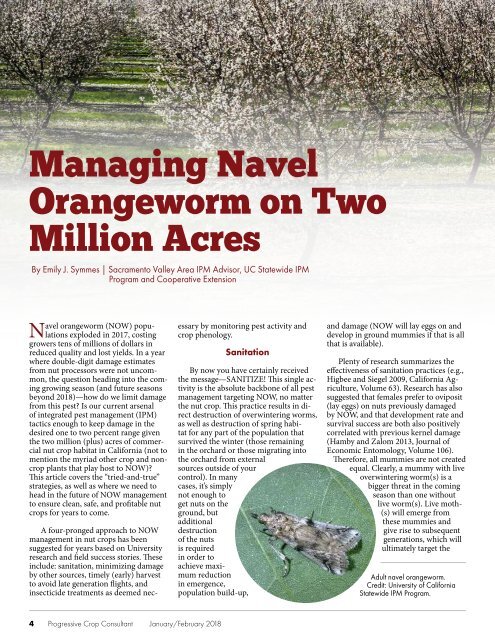You also want an ePaper? Increase the reach of your titles
YUMPU automatically turns print PDFs into web optimized ePapers that Google loves.
Managing Navel<br />
Orangeworm on Two<br />
Million Acres<br />
By Emily J. Symmes | Sacramento Valley Area IPM Advisor, UC Statewide IPM<br />
Program and Cooperative Extension<br />
Navel orangeworm (NOW) populations<br />
exploded in 2017, costing<br />
growers tens of millions of dollars in<br />
reduced quality and lost yields. In a year<br />
where double-digit damage estimates<br />
from nut processors were not uncommon,<br />
the question heading into the coming<br />
growing season (and future seasons<br />
beyond <strong>2018</strong>)—how do we limit damage<br />
from this pest? Is our current arsenal<br />
of integrated pest management (IPM)<br />
tactics enough to keep damage in the<br />
desired one to two percent range given<br />
the two million (plus) acres of commercial<br />
nut crop habitat in California (not to<br />
mention the myriad other crop and noncrop<br />
plants that play host to NOW)?<br />
This article covers the “tried-and-true”<br />
strategies, as well as where we need to<br />
head in the future of NOW management<br />
to ensure clean, safe, and profitable nut<br />
crops for years to come.<br />
A four-pronged approach to NOW<br />
management in nut crops has been<br />
suggested for years based on University<br />
research and field success stories. These<br />
include: sanitation, minimizing damage<br />
by other sources, timely (early) harvest<br />
to avoid late generation flights, and<br />
insecticide treatments as deemed necessary<br />
by monitoring pest activity and<br />
crop phenology.<br />
Sanitation<br />
By now you have certainly received<br />
the message—SANITIZE! This single activity<br />
is the absolute backbone of all pest<br />
management targeting NOW, no matter<br />
the nut crop. This practice results in direct<br />
destruction of overwintering worms,<br />
as well as destruction of spring habitat<br />
for any part of the population that<br />
survived the winter (those remaining<br />
in the orchard or those migrating into<br />
the orchard from external<br />
sources outside of your<br />
control). In many<br />
cases, it’s simply<br />
not enough to<br />
get nuts on the<br />
ground, but<br />
additional<br />
destruction<br />
of the nuts<br />
is required<br />
in order to<br />
achieve maximum<br />
reduction<br />
in emergence,<br />
population build-up,<br />
and damage (NOW will lay eggs on and<br />
develop in ground mummies if that is all<br />
that is available).<br />
Plenty of research summarizes the<br />
effectiveness of sanitation practices (e.g.,<br />
Higbee and Siegel 2009, California Agriculture,<br />
Volume 63). Research has also<br />
suggested that females prefer to oviposit<br />
(lay eggs) on nuts previously damaged<br />
by NOW, and that development rate and<br />
survival success are both also positively<br />
correlated with previous kernel damage<br />
(Hamby and Zalom 2013, Journal of<br />
Economic Entomology, Volume 106).<br />
Therefore, all mummies are not created<br />
equal. Clearly, a mummy with live<br />
overwintering worm(s) is a<br />
bigger threat in the coming<br />
season than one without<br />
live worm(s). Live moth-<br />
(s) will emerge from<br />
these mummies and<br />
give rise to subsequent<br />
generations, which will<br />
ultimately target the<br />
Adult navel orangeworm.<br />
Credit: University of California<br />
Statewide IPM Program.<br />
4 Progressive Crop Consultant <strong>January</strong>/<strong>February</strong> <strong>2018</strong>


















